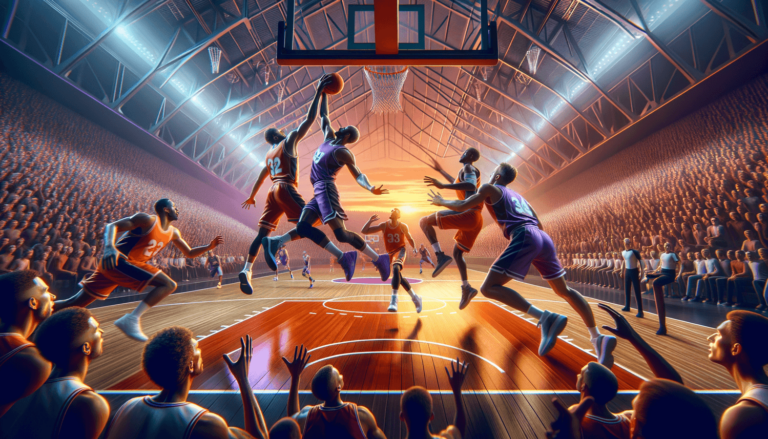
Welcome to the world of basketball, where the action on the court can get intense and physical, sparking rivalries and igniting the passions of players and fans alike! Among various calls that referees make in a game, one that stands out and can potentially alter the rhythm and outcome of the match is the flagrant foul. Ready to dive into the unique aspects of this major offense? In this blog post, we’ll unravel the subtleties of flagrant fouls in basketball, explaining the criteria that warrant such a call, and how the consequences can impact the game. Slip on your sneakers, unleash your inner sports enthusiast, and let’s get this ball rolling!
What Is a Flagrant Foul in Basketball?
A flagrant foul in basketball is a serious, unsportsmanlike violation that involves unnecessary and/or excessive contact towards an opponent. It typically endangers the safety of the player or is deemed as an intentional act with no legitimate attempt to play the ball. Flagrant fouls are divided into two categories: Flagrant 1, which constitutes unnecessary contact, and Flagrant 2, which involves unnecessary and excessive contact. Both categories carry penalties that include free throws for the fouled player and possession of the ball for their team.
Understanding the Importance of Fouls in Basketball
In basketball, fouls act as a regulatory system that keeps the game moving smoothly, ensuring that players engage in healthy competition without causing physical harm to one another. Recognizing when a foul has occurred is crucial in maintaining an enjoyable and fair playing environment. To fully comprehend what a flagrant foul entails, let’s first explore the various types of fouls in the game of basketball.
Decoding the Basketball Foul Hierarchy
Moving up the ladder of severity, fouls in basketball can be divided into three primary categories: personal fouls, technical fouls, and flagrant fouls. Each type carries its own set of implications and consequences, so being able to identify and differentiate between them is essential for players, coaches, and referees alike.
Personal Fouls
Personal fouls make up the majority of fouls called in basketball. These fouls generally involve illegal physical contact, and they can occur in various situations, such as when a defender impedes the progress of an offensive player or makes too much contact while attempting to block a shot. Personal fouls result in either the fouled player being awarded free throws or the opposing team being given the ball out of bounds, depending on the specific circumstances surrounding the foul.
Technical Fouls
Technical fouls do not typically involve physical contact but are still considered serious infractions. They are called for unsportsmanlike conduct or violations of the rules that do not directly relate to gameplay. Examples of technical fouls include arguing with referees, using inappropriate language, or taunting opponents. A technical foul results in one free throw for the opposing team and a possible ejection from the game, depending on the severity of the infraction.
The Anatomies of Flagrant Fouls: Types and Characteristics
As we embark on understanding flagrant fouls in greater detail, you’ll notice two distinct classifications: Flagrant 1 and Flagrant 2. Each has its unique set of attributes and repercussions that we will dive into below.
Flagrant 1 Foul
A Flagrant 1 foul is characterized by contact that the referee deems unnecessary or without a valid attempt to play the ball. Typically, such contact occurs when a player clearly has no intention of playing the ball during a block or steal attempt, or when a player strikes an opponent excessively. The primary consequences of Flagrant 1 fouls are:
- Two free throws for the fouled player
- Possession of the ball for the fouled player’s team
Flagrant 2 Foul
A Flagrant 2 foul is a more severe violation, characterized by contact deemed both unnecessary and excessive. This type of foul typically involves violent acts or those that could potentially lead to serious injury. A Flagrant 2 foul can result in:
- Two free throws for the fouled player
- Possession of the ball for the fouled player’s team
- An automatic ejection of the offending player from the game
What Determines a Flagrant Foul in Basketball?
Referees have a tremendous responsibility in determining what constitutes a flagrant foul. They must factor in the players’ intent, the level of contact, and the specific context in which the infraction occurs. The NBA has provided guidelines to help referees identify flagrant fouls, although the ultimate decision lies in the referees’ judgment. Key factors taken into account when determining if a foul is flagrant include:
Severity of Contact
If a player commits an act with excessive force or creates a high likelihood of injury, a flagrant foul may be called. The severity of contact is evaluated by considering the extent of the contact and the potential for harm it poses to the opposing player.
Intent of the Player
Intent plays a crucial role in distinguishing between different types of fouls. If a player intentionally commits an act that endangers the safety of an opponent or displays unsportsmanlike conduct, they may be charged with a flagrant foul. Determining intent, however, can sometimes be subjective and challenging, which is why referees must rely on their judgment and experience in making such calls.
Whether the Foul Occurred during Play
A player may commit a foul in the natural course of play, and such fouls are usually classified as personal fouls. However, if the foul occurs when the player is not engaged in active gameplay, it can indicate unnecessary or excessive contact, and a flagrant foul may be called.
The Implications of Flagrant Fouls in Basketball
Flagrant fouls carry considerable weight within the game, as they can significantly impact the teams involved, as well as individual players’ careers. Recognizing and addressing the implications of flagrant fouls can contribute to a healthier and more harmonious basketball environment.
Impact on the Game
Not only do flagrant fouls award the fouled player’s team with free throws and possession of the ball, but they can also shift the momentum of the game. Penalties for flagrant fouls can lead to a competitive advantage and trigger strong emotions that fuel the game’s intensity.
Impact on Players’ Careers
Players who repeatedly commit flagrant fouls may develop unfavorable reputations, potentially affecting their future career prospects. Additionally, accumulating flagrant foul points can result in fines, suspensions, or even lengthy bans from games.
Understanding Ejections and Suspensions
Flagrant 2 fouls automatically result in the ejection of the offending player from the game. Players may also be ejected for accumulating two technical fouls during a single game or committing a combination of Flagrant 1 and technical fouls. NBA players receive points for each flagrant foul, with Flagrant 1 fouls accounting for one point and Flagrant 2 fouls contributing two points. Accumulating a certain number of points can result in suspensions, as follows:
- Five points: one-game suspension
- Seven points: two-game suspension
- Nine points: three-game suspension
- Each additional two points: one additional game suspension
In summary, flagrant fouls play a critical role in the game of basketball, maintaining the safety and sportsmanship among players. Understanding the intricacies of flagrant fouls will help you recognize and appreciate their significance while watching or participating in a game. Remember, at the core of basketball is the spirit of fair play, and fouls – flagrant or otherwise – serve as a safeguard for the integrity of the sport. Now that you’re equipped with the knowledge of flagrant fouls, you’re well on your way to becoming a true basketball aficionado!
How Flagrant Fouls are Reviewed and Enforced
One of the key aspects of adjudicating flagrant fouls is the review process, which often comes into play when circumstances are unclear or when a referee’s decision is disputed. Both the NBA and NCAA have procedures in place to ensure that the right call is made in these critical moments.
NBA Flagrant Foul Procedures
In the NBA, instant replay is often used to review and validate a referee’s decision regarding flagrant fouls. Upon calling a flagrant foul, the referee can refer to video footage to determine the level of severity (Flagrant 1 or Flagrant 2) and ensure the proper action is taken. This process allows referees to make well-informed decisions in a relatively short amount of time and helps minimize errors and inconsistencies.
NCAA Flagrant Foul Procedures
The NCAA also employs instant replays to verify calls, specifically for deciding between a Flagrant 1, Flagrant 2, or personal foul. Additionally, the NCAA has implemented an appeal process through which a head coach can request a secondary review of a referee’s flagrant foul decision. In this case, the officials will reconvene and analyze the footage together to reach a definitive conclusion. This allows for a more inclusive decision-making process, ensuring that any flagrant foul is appropriately called.
Examples of Notable Flagrant Fouls in Basketball History
Flagrant fouls can have a lasting impact on the lore and narrative of the sport, sparking discussions and debates among fans and experts alike. Here are a couple of notable examples of flagrant fouls from basketball history that have left a mark on the game:
The Bad Boys’ Physical Defense
The Detroit Pistons, known as the “Bad Boys” in the late 1980s and early 1990s, were notorious for their aggressive style of play. They would use intense physicality in a strategic effort to unsettle opposing teams, often resulting in flagrant fouls. This playing style gave the “Bad Boys” their moniker but also led to rule changes that aimed to reduce the amount of contact allowed during games.
Ron Artest’s “Malice at the Palace”
One of the most infamous moments in NBA history took place on November 19, 2004, during a game between the Indiana Pacers and Detroit Pistons. After a hard foul by Ron Artest (now known as Metta World Peace), multiple players became involved in an altercation that escalated into a full-scale brawl involving both players and fans. Several flagrant fouls were called during this incident, and the NBA took swift action by suspending nine players for a combined total of 146 games, marking the harshest penalties in league history.
Preventing Flagrant Fouls Through Sportsmanship
At its core, basketball is a game centered around camaraderie, teamwork, and sportsmanship. Players, coaches, and referees should strive to cultivate a culture of respect on the court, treating opponents with fairness and avoiding unnecessary aggression. Some helpful tips for promoting sportsmanship and preventing flagrant fouls include:
- Remaining composed and focused during games, even in tense situations
- Respecting the decisions of referees, even if you disagree with a particular call
- Acknowledging good plays made by others, including opponents
- Working collaboratively with teammates to maintain a positive team dynamic
- Learning from mistakes and using those lessons to grow, both on and off the court
By fostering an environment of good sportsmanship, players can help minimize the occurrence of flagrant fouls and contribute to a more enjoyable experience for everyone involved in the game of basketball.
Frequently Asked Questions about Flagrant Fouls in Basketball
Flagrant fouls are a hot topic amongst basketball enthusiasts, raising questions about their implications and the rules that govern them. To address some of the most popular queries, we have compiled a list of frequently asked questions to provide concise and informative answers.
1. What is the main difference between a Flagrant 1 and a Flagrant 2 foul?
A Flagrant 1 foul involves unnecessary contact, while a Flagrant 2 foul consists of contact that is both unnecessary and excessive. A Flagrant 2 foul is more severe and results in an automatic ejection of the offending player.
2. Are flagrant fouls always called on defensive players?
No, flagrant fouls can be called on both defensive and offensive players, depending on the situation and the contact involved.
3. How many free throws are awarded for a flagrant foul?
For both Flagrant 1 and Flagrant 2 fouls, the fouled player is awarded two free throws.
4. What happens after a flagrant foul is called?
After a flagrant foul, the fouled player’s team is awarded with two free throws and possession of the ball.
5. Can a flagrant foul be downgraded or upgraded after being called?
Yes, if a flagrant foul is reviewed using instant replay, referees may decide to downgrade or upgrade the foul based on the contact and circumstances observed in the footage.
6. Can a player be ejected for a Flagrant 1 foul?
A player is not ejected for a single Flagrant 1 foul, but they may be ejected if they accumulate multiple flagrant or technical fouls during the game.
7. Are there instances when a flagrant foul may not be called?
There may be instances when a flagrant foul is not immediately called by the referee, either due to the difficulty in judging intention or the nature of contact. In such cases, the use of instant replay can help review the situation and make the appropriate call.
8. How do flagrant fouls affect the offending player’s career?
Repeated flagrant fouls can lead to a negative reputation, possible fines, suspensions, or bans from future games, all of which could impact a player’s career prospects.
9. Can a flagrant foul be rescinded?
Although rare, a flagrant foul may be rescinded upon review if the officials determine that it does not meet the criteria for a flagrant foul.
10. How does the NBA handle cumulative flagrant foul points?
If an NBA player accumulates a certain number of flagrant foul points, they are subject to suspensions. Five points lead to a one-game suspension, seven points to a two-game suspension, nine points to a three-game suspension, and each additional two points result in an additional one-game suspension.
11. Is there any difference between flagrant fouls in the NBA and the NCAA?
While the basic concept of flagrant fouls remains the same, there can be differences in enforcement, penalty structure, and review processes between the NBA and NCAA.
12. Can a flagrant foul be assessed after the game has already ended?
Typically, a flagrant foul needs to be assessed during the game itself. However, in exceptional cases, basketball governing bodies may review contentious situations post-game and take disciplinary action accordingly.
13. How can players prevent committing flagrant fouls?
Players can minimize the occurrence of flagrant fouls by promoting sportsmanship, staying composed during tense situations, respecting opponents, and focusing on the integrity and the spirit of the game.
Featured Posts
- No pillar pages found.





